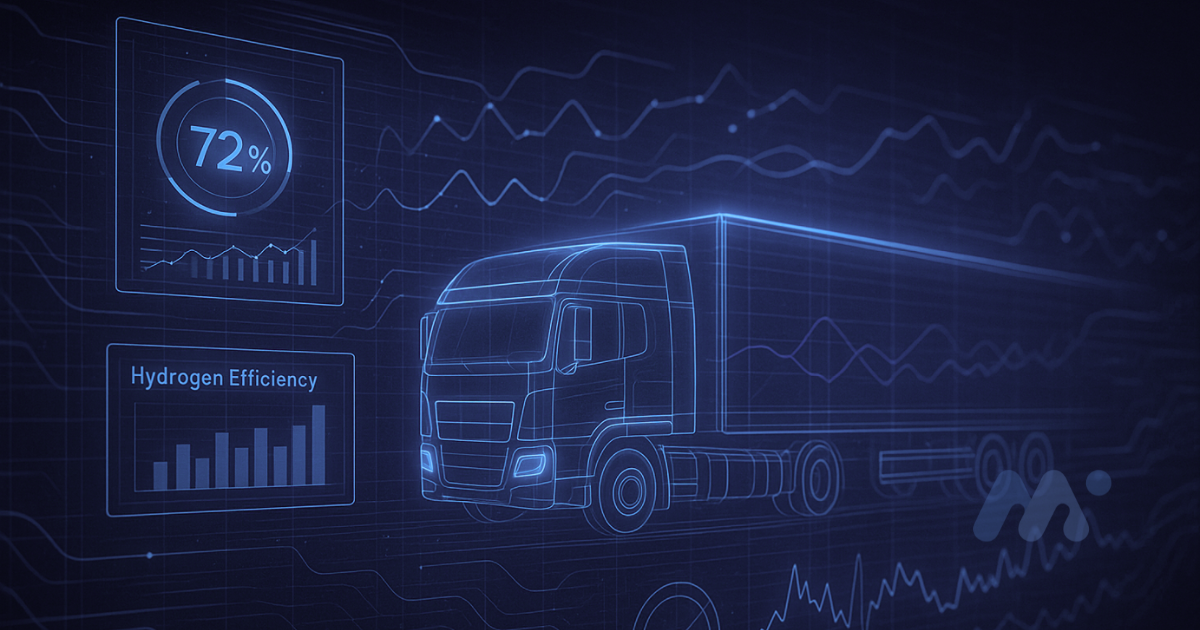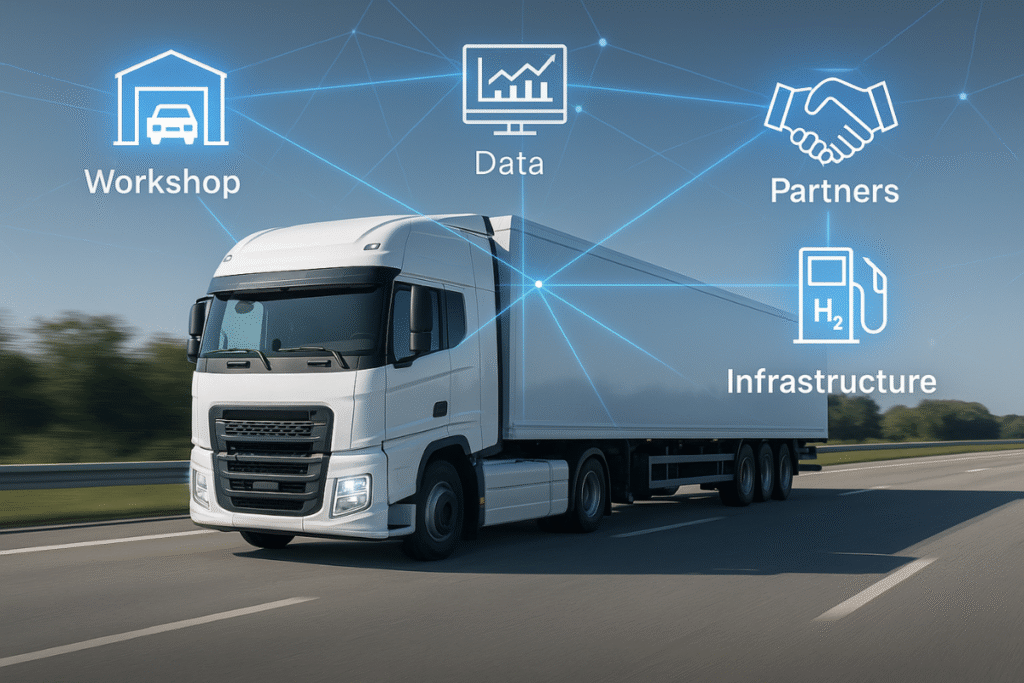How hydrogen propulsion is developed – from concept to real operation

For many, hydrogen propulsion is a symbol of the future.
For us at Mobility & Innovation Production, it is an everyday reality – a technology that is born in the workshop, in the lab and on the road.
Behind every emission-free vehicle is a complex process of development, integration and testing in which everything has to work exactly as it should.
So how does a hydrogen powertrain that can reliably propel a 45-tonne tractor unit come into being?
1️⃣ Concept – from client needs to system design
Every hydrogen project starts with the same question: where will the vehicle go and what does it have to do?
At this stage, the MIP team analyses the customer’s requirements – type of transport, operating conditions, performance, range and hydrogen filling method.
Based on this data, a hydrogen propulsion system architecture is created, which defines:
– the type of fuel cell,
– the capacity of the batteries,
– the power of the electric motor,
– the number and location of the hydrogen tanks,
– as well as the control logic of the entire propulsion system.
Already here, safety standards and EU legislative requirements are taken into account, which will later enable the vehicle to be homologated.
2️⃣ Development and integration of hydrogen propulsion components
Design becomes reality – components arrive in the workshop and the process of system integration begins. MIP engineers combine the fuel cell, traction batteries, electric motor, transmission, cooling and control units into one functional unit.
Each element of the hydrogen propulsion system is connected through a data and electrical architecture that the MIP team is developing in-house. The aim is for the system to respond smoothly, use energy efficiently and meet all reliability parameters – even under high loads.
“As a system integrator, we can combine technologies from different vendors into one functional solution – exactly according to the client’s needs.”
3️⃣ Safety as the basis for hydrogen propulsion development
Working with hydrogen requires the highest degree of safety. Every tank, valve and connection of the hydrogen drive is tested to a pressure of 700 bar. Leak tests, pressure tests and verification of the system’s tightness under extreme conditions are carried out.
Alongside this, electrical safety is also addressed – isolation of high-voltage parts, protection circuits and software backups. The result is a hydrogen drive that not only meets legislative standards, but also MIP’s internal standards – often more stringent than required by regulation.

4️⃣ Hydrogen propulsion testing – from the lab to real operation
Once the system is integrated, comes the testing phase. First in laboratory conditions – parameter verification, simulation, calibration. Then in real-life operation – where it will be shown how the technology works in practice.
The cooperation with METRANS enabled MIP to obtain data from real logistics operations. These tests confirmed that the hydrogen propulsion system is capable of operating at full load, with a range of 600-750 km and a consumption of less than 7 kg H₂ per 100 km.
“For us, testing is not the end of development – it’s the beginning of improvement.”
5️⃣ Vehicle integration and final homologation
Only after thorough testing is the hydrogen propulsion system implemented in the target vehicle. This is followed by final tuning, checking of all parameters and preparation for the homologation tests.
In 2024, MIP successfully homologated Europe’s first hydrogen tractor unit based on the Ford Trucks F-MAX platform. This confirmed that Slovak development can keep up with the latest global trends in hydrogen propulsion and emission-free mobility.
6️⃣ The future of development: modular solutions and tailor-made drives
The development of hydrogen propulsion does not stop at one type of vehicle. Thanks to its modular architecture, MIP is able to adapt the technology to different segments – from city buses to heavy logistics or special machinery.
The future belongs to flexibility – and it is the system integration of customized drives that allows each project to be optimized for the customer’s specific needs.
Conclusion
Hydrogen propulsion is the result of a combination of engineering precision, technological know-how and real data from operation. At Mobility & Innovation Production, we believe it is this combination that makes hydrogen not only a vision, but also a workable solution for today’s transportation.
The future of mobility is not created in the lab – it is born on the ground.
FAQ – Frequently asked questions about hydrogen propulsion
1️⃣ How does hydrogen propulsion work?
Hydrogen propulsion converts energy from hydrogen into electricity using a fuel cell. A chemical reaction between hydrogen and oxygen takes place in the fuel cell, producing electricity, water and heat. This electricity then powers the vehicle’s electric motor – with no combustion, no noise and zero local emissions.
2️⃣ What are the main components of a hydrogen system in a vehicle?
- Fuel cell – a source of electricity from hydrogen,
- Hydrogen tanks – safely store hydrogen at pressures up to 700 bar,
- Batteries – serve as an energy buffer at peak power,
- Electric drive and control unit,
- Cooling and safety system.
Each component must work together as part of a whole – this is the core of systems integration at which MIP excels.
3️⃣ How is hydrogen propulsion testing going?
- Laboratory tests – verification of system performance, efficiency, tightness and response.
- Real field testing – tests in logistics and transport conditions to verify reliability and consumption.
At MIP, for example, we tested a hydrogen tractor in cooperation with METRANS and Waberer’s, which provided valuable data from real operation.
4️⃣ Is hydrogen propulsion safe?
Yeah. Hydrogen propulsion meets strict EU safety standards. Every component undergoes pressure tests, leak tests and inspection under extreme conditions. What’s more, MIP uses in-house testing protocols that are even more stringent than the legislative requirements – because safety is at the heart of every project.
5️⃣ How long does it take to develop a hydrogen powertrain for a single vehicle?
The process from initial design to final integration usually takes several months, depending on the type of vehicle and the complexity of the project. The advantage of MIP system integration is that development time can be reduced by using proven modules and experience from custom homologated vehicles – such as the M&I RH120R hydrogen tractor.
6️⃣ Where can hydrogen propulsion be used?
- 🔹 city and intercity buses,
- 🔹 Heavy logistics and long distance transport,
- 🔹 municipal and special vehicles,
- 🔹 Industrial and construction machinery.
Thanks to its modularity, MIP is able to adapt the system to specific needs – a tailor-made drive for every type of operation.
7️⃣ What is the realistic range of a hydrogen-powered vehicle?
Hydrogen-powered vehicles have a range of 600-750 km per fill-up. Filling takes less than 10 minutes, making the technology ideal for heavy and long-haul transport where quick turnaround and high vehicle availability are required.
8️⃣ Why MIP?
MIP is an independent system integrator – not tied to one vendor or technology. This allows the solution to be designed exactly to the client’s needs: hydrogen, electric or hybrid. We combine development, production, testing and homologation under one roof – to make emission-free mobility work in practice, not just on paper.